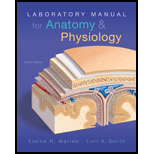
When the semilunar valves are open, which of the following are occurring? (a) 2, 3, 5, 6, (b) 1, 2, 3, 7, (c) 1, 3, 5, 6, (d) 2, 4, 5, 7.
_____(1) coronary arteries fill
_____(2) AV valves are closed
_____(3) ventricles are in systole
_____(4) ventricles are in diastole
_____(5) blood enters aorta
_____(6) blood enters pulmonary arteries
_____(7) atria contract
To determine:
The correct occurrence of sequences if semilunar valves are open
(a) 2, 3, 5, 6, (b) 1, 2, 3, 7, (c) 1, 3, 5, 6, (d) 2, 4, 5, 7
____ (1) coronary arteries fill
____ (2) AV valves are closed
____ (3) ventricles are in systole
____ (4) ventricles are in diastole
____ (5) blood enters aorta
____ (6) blood enters pulmonary arteries
____ (7) atria contract
Answer to Problem 1MC
Solution:
(a) 2, 3, 5, 6: The events that occur when the semilunar valves are open are listed as follows:
1. The closing of atrioventricular valves.
2. The ventricles are in the systolic stage.
3. The blood enters the aorta.
4. The blood enters the pulmonary arteries.
Explanation of Solution
The semilunar valve is situated between the left ventricle and aorta of the heart. The opening of the semilunar valves marks the systolic stage. The atrioventricular valves at this stage are closed in order to prevent the backflow of the blood. The blood is pumped to the aorta and the pulmonary artery to distribute it to the different parts of the body.
Want to see more full solutions like this?
Chapter 17 Solutions
Laboratory Manual for Anatomy & Physiology (6th Edition) (Anatomy and Physiology)
- Figure 40.11 Which of the following statements about the heart is false? The mitral valve separates the left ventricle from the left atrium. Blood travels through the bicuspid valve to the left atrium. Both the aortic and the pulmonary valves are semilunar valves. The mitral valve is an atrioventricular valve.arrow_forwardLabel the hearts main parts in the diagram below.arrow_forward(i)List the major blood vessels and their origins involved in coronary circulation.(ii) At what stage or phase of the heart’s activities does the heart tissues becomes perfused with oxygenated blood? (iii) Define myocardial infarction.(iv) Explain the typical signs associated with acute myocardial infarction. (v) Outline/State which arteries of the heart are most commonly affected/occluded.(vi) Explain why occlusions lead to infarct in the heart.arrow_forward
- In a healthy adult blood flow in the left coronary artery is less during systole than diastole. This difference is best explained by a change in which of the following (a) Coronary arterial Po2 (b) Extravascular Pressure (c) Flow through the aortic valve (d) Parasympathtic nerve activity (e) Sympathetic nerve activityarrow_forwardList the major blood vessels and their origins involved in coronary circulation. (ii) At what stage or phase of the heart’s activities does the heart tissues becomes perfused with oxygenated blood? (iii) Define myocardial infarction. (iv) Explain the typical signs associated with acute myocardial infarction. (v) Outline/State which arteries of the heart are most commonly affected/occluded. (vi) Explain why occlusions lead to infarct in the heart. (vii) What is creatine phosphokinase (CPK) and why are elevated CPK levels in the blood suggestive of a myocardial infarction? (viii) What is cor pulmonale? (ix) Describe the main clinical findings (with cor pulmonale) on examination. Explain your answer.arrow_forwardDuring a cardiac angiogram, it is discovered that a 58-year-old patient has moderate stenosis of the left circumflex artery. Which chamber of the heart would be impacted by this blockage?arrow_forward
- mr. Holmes, a 72-year-old Caucasian male, suffered a heart attack which resulted in damage to a papillary muscle holding down the mitral valve. As a result the mitral valve is prolapsing with each heartbeat, which enables the backflow of blood. Where is this blood back flowing to? left ventricle, left atrium, or the aorta.arrow_forwardWhich of the following are the cardinal signs of cardiac arrest? (A) Apnea, carotid pulses and dilated pulses (B) Pinpoint pulses, absent pulse, flushed skin (C) Cool pale skin and absence of radial pulse (D) Cyanosis, slow pulse and dilated pulsesarrow_forwardIdentify this vessel (A) right coronary artery (B) left coronary artery (C) anterior interventricular artery (D) marginal artery (E) posterior interventricular artery (F) circumflex arteryarrow_forward
- Valve regurgitation is yet another condition causing heart failure. This condition is characterized by _________________. 1)the hardening of a valve, narrowing the opening that serves as a passage of blood. 2) a valve that everts back into the previous chamber, blockig blood from progressing into the ventricle. 3) a valve that does not close completely, and allows blood to leak back into the previous chamber. 4)a valve with an opening that is too narrow, not allowing for sufficient blood to travel to the next chamber.arrow_forwardHeart disease is the leading cause of death around the world. One of the most common complications of heart discase is heart failure which occurs when heart cannot pump enough blood to meet body needs. (i) Discuss the most common cause of failure to the right ventricle.arrow_forwardBlood flow through the capillaries is steady despite the rhythmic pumping action of the heart because of the (a) elasticity of the large arteries only, (b) elasticity of all the arteries, (c) ligamentum arteriosum, (d) venous valves.arrow_forward
 Fundamentals of Sectional Anatomy: An Imaging App...BiologyISBN:9781133960867Author:Denise L. LazoPublisher:Cengage Learning
Fundamentals of Sectional Anatomy: An Imaging App...BiologyISBN:9781133960867Author:Denise L. LazoPublisher:Cengage Learning Human Physiology: From Cells to Systems (MindTap ...BiologyISBN:9781285866932Author:Lauralee SherwoodPublisher:Cengage Learning
Human Physiology: From Cells to Systems (MindTap ...BiologyISBN:9781285866932Author:Lauralee SherwoodPublisher:Cengage Learning Biology 2eBiologyISBN:9781947172517Author:Matthew Douglas, Jung Choi, Mary Ann ClarkPublisher:OpenStaxBasic Clinical Lab Competencies for Respiratory C...NursingISBN:9781285244662Author:WhitePublisher:Cengage
Biology 2eBiologyISBN:9781947172517Author:Matthew Douglas, Jung Choi, Mary Ann ClarkPublisher:OpenStaxBasic Clinical Lab Competencies for Respiratory C...NursingISBN:9781285244662Author:WhitePublisher:Cengage





